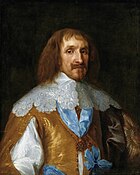Palace on the Isle
| Palace on the Isle Pałac Na Wyspie | |
|---|---|
 North façade | |
 | |
| General information | |
| Architectural style | Neoclassical |
| Town or city | Warsaw |
| Country | Poland |
| Construction started | before 1683[1] |
| Completed | 1689 |
| Client | Stanisław Herakliusz Lubomirski, Stanislaus II Augustus |
| Design and construction | |
| Architect(s) | Tylman Gamerski, Domenico Merlini (1775–1795) |
Historic Monument of Poland | |
| Designated | 1994-09-08 |
| Part of | Warsaw – historic city center with the Royal Route and Wilanów |
| Reference no. | M.P. 1994 nr 50 poz. 423[2] |
The Palace on the Isle (
From 1674 this palace and the nearby
In 1766 King
During the final stages of World War II, the retreating Germans devastated the interior of the Palace and drilled holes in the structure in preparation for destruction with explosives. However, the plan was never carried out.
In 2019 the palace was 11th on the list of most visited palaces and monuments in the world, attracting over 4.9 million visitors.[3]
History


The building began as a bath-house for
Finished in 1689, it was intended to serve as a bath-house, habitable pavilion, and a garden
.Other chambers had richly decorated
King Stanisław August Poniatowski decided to convert the property into private quarters, and between 1764 and 1795 it was remodeled by Domenico Merlini.
During World War II, the Germans drilled holes into the walls for explosives but never got around to blowing up the palace.[4] The palace served as German barracks.
Architecture

The palace is built on an artificial island that divides the lake into two parts, a smaller northern lake and a larger southern one. The palace is connected to the surrounding park by two
Interiors

by Ludomir Dymitrowicz (1844-1923)
On the palace's ground floor is the Bacchus Room, decorated with 17th-century Dutch blue tiles and a painting by Jacob Jordaens depicting Silenus and Bacchantes.[5] The 1778 ceiling painting, Bacchus, Ceres, Venus and Cupid by Jan Bogumił Plersch, was burned by German forces in 1944.[6] The Rotunda, designed by Domenico Merlini, occupies the central portion of the palace. Decorated in yellow and white marble, with figures of the Polish kings, it is one of the most important examples of neoclassical decoration within the palace. It leads to the Bath Room and the Ballroom.
On the other side of the Rotunda is the lower Picture Gallery, which contains works by

The Solomon Room, one of the largest of the palace's ground-floor interiors, was embellished with a series of paintings depicting the History of Solomon.
In the years 2012–2015, the palace underwent further renovations, which covered the roof as well as all the rooms of the palace including the Ball Room in which 17th-century wall paintings by Jan Bogumił Plersch were unveiled. In 2016, the palace and park received an estimated 2.1 million visitors.[9]
Gallery
- Palace on the Isle
-
The northern façade of the palace
-
A bridge leading to the palace
-
A statue depicting the Allegory of theBug River
-
A lake surrounding the palace
-
The palace and park
-
Palace on the Isle at night
- Artwork
-
Portrait of Jacqueline de Caestre, Peter Paul Rubens, ca. 1618
-
Portrait of Jean Charles de Cordes, Peter Paul Rubens, ca. 1618
-
Temptation of St. Anthony, Jan Brueghel the Younger, 17th century
-
Portrait of Philip Herbert, 4th Earl of Pembroke, Anthony van Dyck, ca, 1634
-
Portrait of Francis Bacon, Frans Pourbus the Younger, 1617
-
Silenus and Bacchantes, Jacob Jordaens, first half of 17th century
-
Allegory of Graciousness, Marcello Bacciarelli, ca. 1792
-
View of the Royal Baths Palace in Summer, Marcin Zaleski, ca. 1837
-
Allegory of Africa, turn of 17/18th century
-
China earthenware, 18th century
-
Japanese Imari vase with Foo Dog, late 18th century
-
A Rococo putto by André Le Brun, ca. 1783
-
Table top with a bull by Pompeo Savini, ca. 1788
See also
- Baroque in Poland
- Polish classicism
- List of most visited palaces and monuments
Notes
- ^ a b c d "Lubomirski's Bathhouse". Varsovia.pl (in Polish). Archived from the original on 2008-05-20. Retrieved 2008-02-09.
- ^ Zarządzenie Prezydenta Rzeczypospolitej Polskiej z dnia 8 września 1994 r. w sprawie uznania za pomnik historii., M.P. z 1994 r. Nr 50, poz. 423
- ^ "Kultura w 2019 roku". stat.gov.pl (in Polish). 30 September 2020. Retrieved 20 August 2023.
- ^ "Historia". Muzeum Łazienki Królewskie (in Polish). Retrieved 2008-02-09.
- ^ Identified as a painter's own work by Roger Adolf d'Hulst (d'Hulst 1974, Vol. 1, pp. 240-241).
- ^ "Pokój Bachusa". Muzeum Łazienki Królewskie (in Polish). Retrieved 2008-02-09.
- ^ "Royal Baths Museum" (in Polish). culture.pl. Retrieved 2008-02-09.
- ^ a b c "Sala Salomona - Palac na Wyspie". Muzeum Łazienki Królewskie (Royal Baths Museum) (in Polish). Retrieved 2010-02-19.
- ^ "EGMUS 2016". Retrieved 23 November 2019.
Further reading
- Władysław Tatarkiewicz, Łazienki warszawskie (Warsaw's Łazienki), [with photographs by] Edmund Kupiecki, Warsaw, Wydawnictwo Arkady, 1968. (Polish-language text, with summaries in English, French, and Russian.)
- ISBN 83-213-3162-9. (Polish-language text, with summaries in English, French, German, and Russian.)
External links
- (in Polish) Official site
- (in Polish) Lubomirski's Bathhouse





















